*This is the webinar transcript, you can watch the video recording
WEBINAR: Psychological Self-Healing
Hello, everyone and welcome!
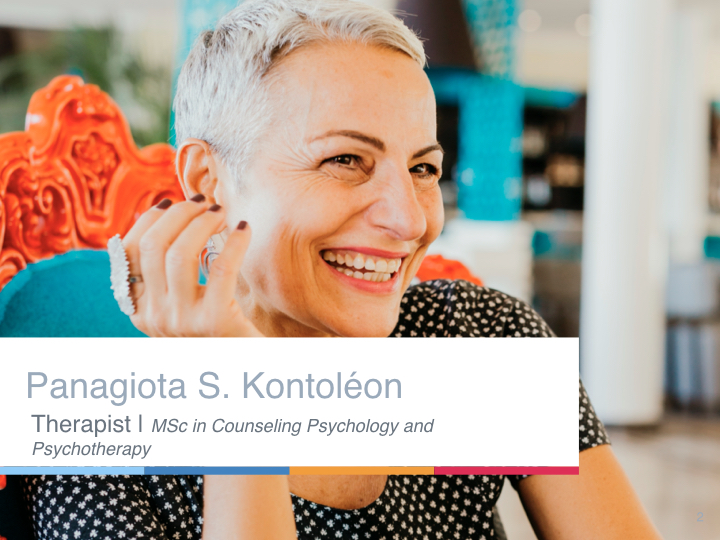
For those of you who do not know me, my name is Panagiota Kontoleon and I am originally from Athens, Greece. I am part of the Radiant Life Technologies team, the coMra team for a decade now and my calling is to help people help themselves. I am a certified coMra practitioner and hold a Masters degree in Counseling Psychology and Psychotherapy.
My training is in integrative psychology, which uses a holistic approach to treatment. Integrative psychotherapists use multiple treatment approaches because no two people are the same and many people will benefit from a combination of treatment styles.
Unlike the traditional mental health practices, integrative psychology utilizes different schools of psychology as we view the individual as whole, so we work with them in a holistic approach to improve their lifestyle quality. I am also a member of APA, the American Psychologists Association based on my post-secondary US education and American citizenship as well.
What Is Psychological Healing?
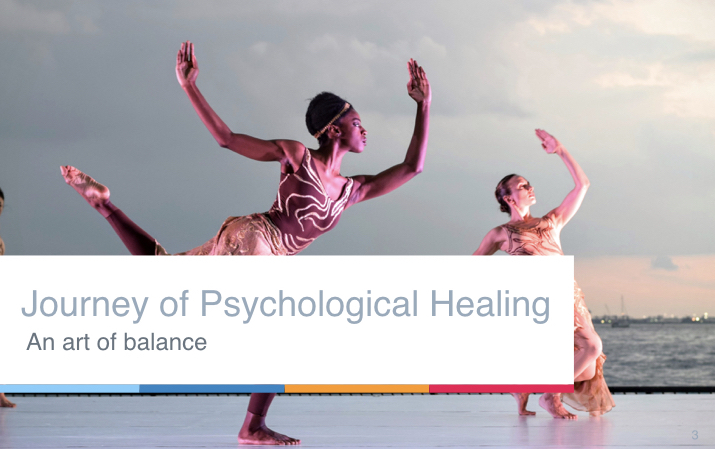
The coMra webinar series are based on true healing and today I will do my best to discuss psychological self-healing. I want to thank the coMra webinar team who supported me in the creation of this presentation, and without further ado, I will move on.
Psychological healing is a vast subject, as you can imagine and definitely not something that I would attempt to address in just one hour in this presentation. The psyche has been the subject of philosophical discussions and debates for many centuries already before psychology appeared as a scientific method to explain this invisible aspect of human behavior as well as mental and emotional states. You may already know that there are different approaches to psychotherapy.
Based on APA, there are 5 main approaches to psychotherapy: Psychoanalytic – Psychodynamic therapy (based on Sigmund Freud’s theory); Behavior therapy; Cognitive therapy; Humanistic therapy; Integrative or Holistic therapy – on which my training is based. Additionally, under these approaches there are many branches and even more types, which are beyond the scope of this presentation.
- What Is Psychological Healing?
- Defining The Words I Will Use
- What Does Healing Mean?
- The Importance of Respect
- The Nature of Inner Conflict According to Plato
- The Man of Today – A Modern Journey
- How the Personality Is Formed?
- The Attachment Theory
- Early Childhood – the Formative Years
- Puberty – A Period of Profound Transition
- How to Identify Cognitive Distortions?
- How Can We Truly Heal Ourselves – The Journey of Adjustment
- Psychological Self-Healing
- Experiencing Joy
- Useful Tools To Support Your Journey Towards Joy
Defining The Words I Will Use
Before we begin, I would like to take a minute, or two to define some words which I will be using throughout the presentation perhaps in a slightly different way than expected.
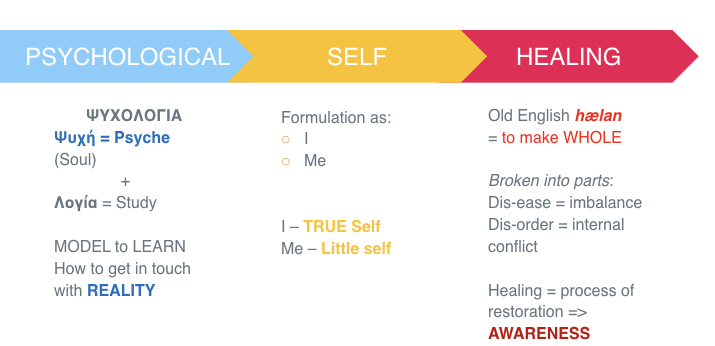
The word psychology derived from the Greek word ΨΥΧΟΛΟΓΙΑ, the etymology of which has 2 roots: the word «Ψυχή» which means “psyche” and the word «Λογία», which means “the study of”. I will use the word psyche interchangeably with the word Soul, as in Greek mythology Psyche was actually the Goddess of the Soul. Psychology, as we see, means the study of the soul. Psychology is one model we use to learn, to get in touch with reality. We must not get stuck in the model, rather use it as a mirror of our Psyche, our Soul.
Now, the Self: The earliest formulation of the self in modern psychology forms the distinction between the self as I, and the self as Me. The “I” is the True Self, the liberated – the divine Soul as it is connected with everything, and this part is often called the “Observing Self”, the “Witness”, “Higher Self” or the “True Self” as I will be referring to it from now on.
The “me” is the little self, the part that identifies with the self-image, the fake identity that we consider to be our self. It is based on a conglomeration of recurring thought forms and conditioned mental and emotional patterns, resulting in a distorted perception of the self.
It is often called the Ego, the Superficial Self, or the Little Self, which is how I will be mostly referring to it, for the purposes of this presentation. What we see here, is what seems to be a duality of the self, and I will later elaborate on this, and will share a personal example for better understanding. For now, it suffices to say that the connection with the Truth is only through our True Self.
What Does Healing Mean?
The next word is Healing. It derives from the Old English word hælan which literally means “to make whole“. And when do we need to make something whole? When it is broken into pieces, into parts, no? When we discuss physiology, a disease is a result of an imbalance. However, when we discuss psychology, a mental disorder is a result of an internal conflict. Both result in a form of separation inside, in the creation of little parts inside which are not in harmony. Therefore, healing is a process of restoration of this imbalance, this internal conflict and the first step to healing is awareness as everything starts from there!
Thus, in order to begin the journey of our Psychological Self-Healing, if we read from right to left now, the first step is to be aware of this imbalance, this internal conflict between our different parts of our Psyche and connect with our True Self to come in touch with reality. And when I say reality, I refer to the One Truth and not what we think reality is. This is the journey to true healing.
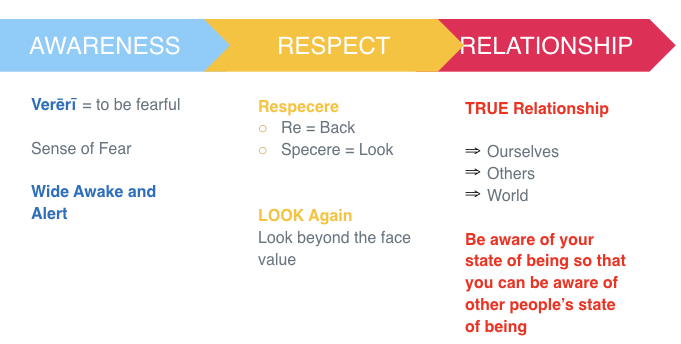
As I said, the first step towards this journey is awareness, and I would like to define this word so that we are all on the same page. The word awareness derives from the Latin word verērī, which means “to be fearful”. To have a sense of fear, which is useful in order for us to be wide awake and alert. Two weeks ago, I hosted a webinar about the Fear of Conflict and it was essential to explain the difference between the sense of fear, and the fear as a debilitating state.
A sense of fear helps to protect you. It makes you alert to danger and prepares you to deal with it. It is actually very natural and helpful. As a swimmer, I will use an example in this context. Let’s say someone who isn’t a strong swimmer might have a sense of fear of deep water. In this case, the fear is helpful because it cautions the person to stay safe. Someone could overcome this sense of fear by learning how to swim safely.
Further on, in order to truly relate with ourselves and others, we need to respect the relationship, a word which I would also like to define as often we use words without being clear of what they mean exactly.
The Importance of Respect
The word respect derives from the Latin verb re-specere, the roots of which are the word “re” which means back or again and the verb “specere” which means to look. The word respect means to look again at it, to look beyond the face value, to see what is really going on.
In order to have a true relationship with yourselves, others and the world around you, that is how well you connect, you relate to yourself and others, you need to have awareness and to respect your state of being in order to be able to do the same for the other person’s state of being. Because if you are fast asleep and take yourselves for granted, it is not possible to relate properly, is it? And this is the beginning of the internal conflicts and imbalances which bring about diseases and mental disorders.
I will be revisiting these concepts and their meanings in the course of the presentation when needed.
Discussing the Psyche
Now that we defined these important words and concepts, let us start the journey of healing by discussing the Psyche. In order to explain it as best as possible and in a light and fun way the process of the liberation of the Soul for true psychological healing, I will borrow the tools of Narrative Psychology and will tell you a story.

And as a good Greek, it is a myth, an allegory of Plato’s Republic called the Phaedrus myth, the myth of the winged Soul. Phaedrus means bright or radiant and in this myth Socrates discusses with Phaedrus unconditional love and is narrating the nature of the human Soul using an allegory of the chariot. The myth goes like this:
Souls, both divine and human, travel to heaven. Each one is depicted as a winged chariot drawn by 2 horses and driven by a charioteer.
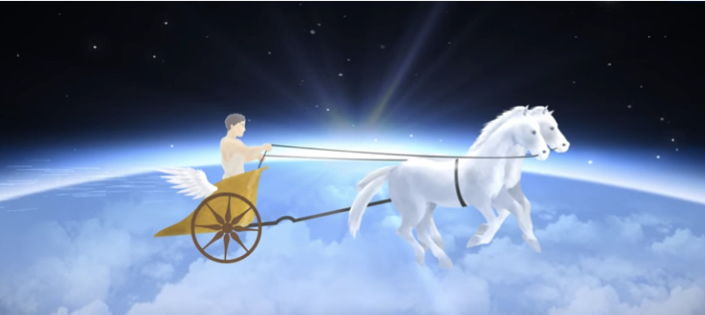
The Charioteer is the mental, the logical part of the Soul, the part that has the ability to think, to reason, to evaluate, to reckon, to judge rightfully and it is the eyes of the Soul. Its role is to control the horses. The virtue of this part is wisdom.
One of the horses is the Steed, which symbolizes the spirited part of the soul, the part associated with our emotions and volition. It is the part of our soul that arms us with courage and gallantry to overcome obstacles, to tackle challenges and to do what the charioteer requires. The virtue of the Steed is bravery.
The other horse symbolizes the Appetitive part. Appetitive derives from the word appetite, meaning the part of the Soul connected to the desire to satisfy bodily needs, such as the need for food, reproduction, etc., and is also connected with ennoble desires. The virtue of the Appetitive horse is prudence.
As the souls travel, they reach a point where the area beyond the heavens becomes visible. This is where the true being, the truth itself is to be found. The horses of the divine souls, the liberated souls, are good and calm. They follow the commands of the charioteer who holds the reins firmly. The liberated souls can thus contemplate undisturbed the essence and the truth of things, pure love. Therefore, when these three parts of the soul are in harmony, they are perfectly winged, they are coherent, then they soar upwards and the Soul experiences Beauty, Wisdom and Goodness.

This is not the case, however, with the human souls, the non-liberated ones. Here, the horses behave differently and, as you see, they are different in color

The horse that symbolizes the spirited part, the high mind, the noble part is white. Its body is upright in frame and well jointed. Its neck is high and it has a regal nose and black eyes. It is a lover of honor, with humility and self-control. It is also a lover of truth. It needs no whip and is guided only by verbal commands.
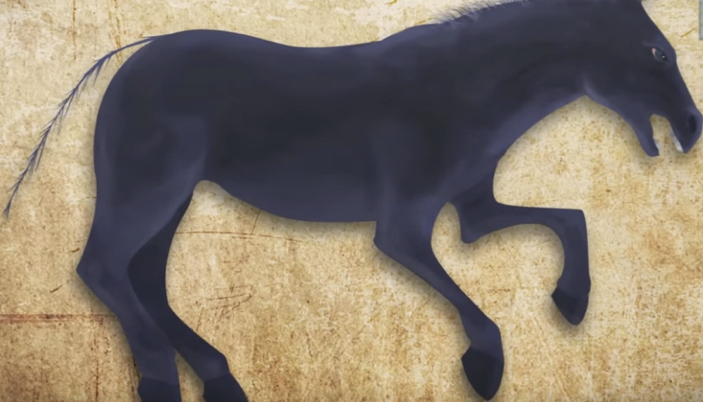
The other horse, which symbolizes the appetitive part, is black and untamed. Its body is crooked, fat and ill-shaped. It has a thick short neck, broad face and grey bloodshot eyes. It is also deaf. This horse tends towards hubris and arrogance, and barely obeys to the stings and the lashes of the charioteer with the whip.
In some human souls, the charioteers raise their head to see what lies beyond the heaven. The horses however, do not obey all the commands. The attention of the charioteers is drawn away from what they see and focus on controlling the chariot. Thus, these souls can see a great part but not the whole truth.
The horses of some other human souls are more untamed. They do not obey commands; they do not coordinate their movements and drag the chariots downwards. The charioteers try to control them by pulling the reins firmly. Only occasionally they are able to turn their heads to the region beyond heaven. As a result, they can see only a small part of the truth.
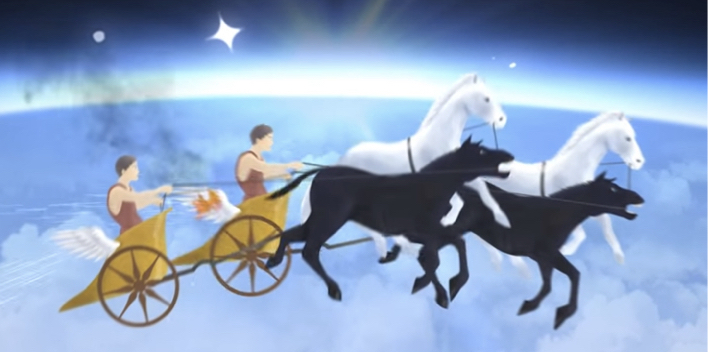
And, the horses of some human souls are extremely wild. They whinny, they rear up on their legs. They run into one another while the charioteers struggle to stay upright. No matter how hard they try they are unable to control the chariots. The souls are trampled, one drags the other, their wings are destroyed and they never manage to catch a glimpse of the truth.
The Nature of Inner Conflict According to Plato
Plato used this allegory to represent the inner conflict of these three parts, which bring about imbalance and disease. He claims that a prerequisite for mental health is the harmonization of these three parts of our Psyche, and in fact so that the mental part decides, the emotional and willful part provides the necessary strength to achieve the goal and the appetitive part to satisfy basic needs, always obeying the choices of the Eyes of the Soul.

Plato later on used an image to depict this inner conflict. The mental part of the Psyche is represented by a Man, the part related to Emotions and Volition by a lion, and the Appetitive part by a multi-headed beast. If the Man lets the Lion and the Beast become stronger at the expense of the Man, then they will fight fiercely, leading him to an unholy life, a slave to his opposing desires and passions, as well as the outbursts of his rage. But if the Man manages to tame the Beast with the help of the Lion, then he will be able to discipline his desires and uproot his passions, in order to enjoy the pleasure of harmony in his soul and experience the One Truth, the Unconditional Love.
Plato by no means suggested that the Man should try to annihilate the Beast or the Lion within. On the contrary, he proposes to the Man is to satisfy the desire in a balanced way so that it is not hooked on deprivation or over fulfilling. Thus, in this state of balance, to allow the Man to search for true knowledge. If the inner conflict is managed, then there is always new knowledge and thus the Soul gets one step closer to its divinity.
The Man of Today – A Modern Journey

Let us now fast forward to the Man of Today, Man meaning human and not male, right? We will embark together on a modern journey now, the journey of life. There are two parts of it. The first part depicts how you lose connection with your True Self as you grow up, due to social conditioning and as you identify with the self-Image.
The second part is the Journey of Adjustment – the journey of healing that begins once you become aware that you have been ignoring your True Self. Then, you respect the relationship and you change course towards finding joy in your life. Throughout the remaining presentation I will be sharing parts of my journey and my life to provide some examples.
Every Baby Is In Unity with Everything
Everyone starts the journey as a baby, this is when it all begins. Right before we arrive in this world, our Soul is one with everything around, it is like the divine Soul in the Phaedrus myth. There is unity with everything.
However, the moment we take our first breath and start interacting with the world around us, we start moving away from this connection due to the social conditioning. Social conditioning is the process of being trained to respond in a certain manner, usually approved by the society in general and by peer groups within society later on. This is when our personality starts to form.
How the Personality Is Formed?
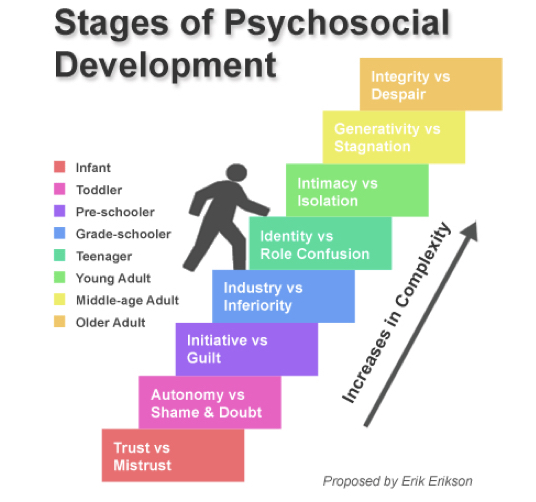
I will use two theories of psychology to briefly discuss this process. The first is Erik Erikson’s theory of psychosocial development. He claims that at each stage of development the individual is undergoing specific internal conflicts and based on how this stage is resolved, the emotions and traits are internalized and are carried over to the next stage, i.e., they stay there throughout your lives unless, of course, you start working with yourselves.
Very briefly, you can see here at the lower parts of our development, specifically the first three stages from birth to 6 years old, the internal conflicts have to do with Trust vs Mistrust (from 0-1), Autonomy vs Shame or Doubt (1-3), and Initiative vs Guilt (3-6). What I would like to bring to your awareness with this slide is that by the age of 6 years there comes the Mistrust, the Shame, the Doubt and the Guilt. Amazing, right?
The Attachment Theory
The second and my favorite theory that I use extensively in my practice, is the Attachment Theory. The theory of attachment was originally develоped by John Bowlby in an attempt to understand the intense distress experienced by infants who had been separated from their parents.
Bowlby observed that separated infants would go to extraordinary lengths (e.g., crying, clinging, frantically searching) to prevent separation from their parents or to reestablish proximity to a missing parent. And then, his assistant Mary Ainsworth went a step further in observing how fast the children would calm down upon reestablishment of proximity with the parent.
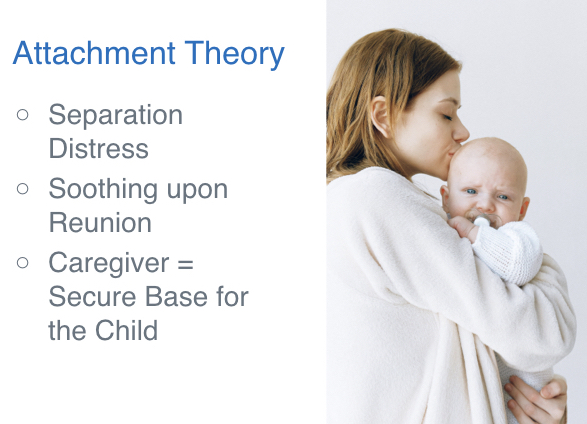
If I could put a huge theory in a sentence, I would say that Attachment theory views the primary caregiver, in most cases the mother, as a secure base for the child, from which the child could move away in order to explore the world around, and in a case of distress to be able to go back and feel safe again that is the mother needs to be there, solid and consistent.
The common ground here with Erikson’s theory is the balance between Autonomy and Trust, which Erikson had in his first two stages of development combined from birth to 3 years of age.
According to Bowlby, the attachment system essentially “asks” the following fundamental question: Is the attachment figure – in most cases the mother – nearby, accessible, attentive and consistent in her behavior?
Secure or Insecure Attachment?
If the child perceives the answer to this question to be “yes,” he or she feels loved, secure, and confident, and, behaviorally, is likely to explore his or her environment, play with others, and be sociable, which are important skills for a healthy development. And even when separated with the mother and experiences distress, when the mother is back then the child is soothed right away in her arms, stops crying and returns to the activity of playing right away. This is what we call secure attachment because there is balance between the child’s autonomy – to be able to be alone for a while and go explore around – and the child’s ability to trust that his or her needs will be met when needed.
This balance is similar to the two horses of the chariot in Phaedrus myth where, when they work together and there is balance between the courage and bravery (similar to what is needed for the autonomy for children) and the attendance to the bodily desires (for the children to be hugged and fed for example) then the charioteer can lead the chariot without any waste of energy towards The One Truth.
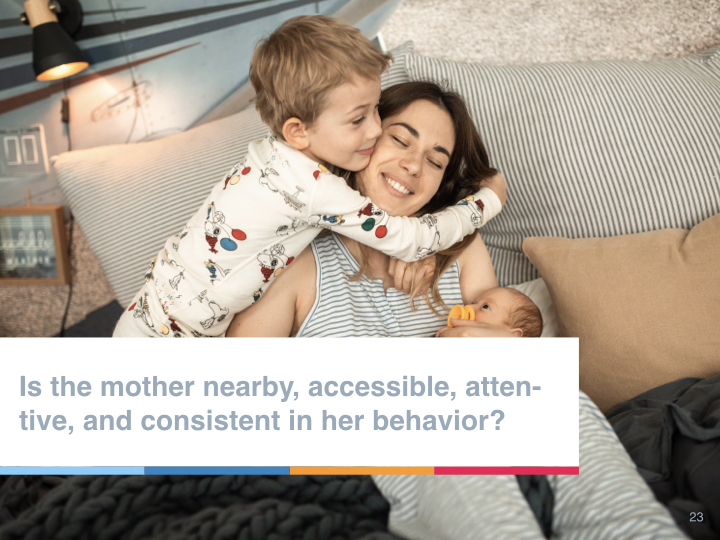
As adults, securely attached individuals are more empathetic, they are better at handling conflicts, they are confident in relationships, they are willing to ask for support and are generally positive towards others and themselves. Overall, they experience joy in their lives.
If the child perceives the answer to this question (Is the attachment figure nearby, accessible, attentive, and consistent in her behavior?) to be “no“, these children have, what we call, an insecure attachment style, which could be either anxious-resistant, or avoidant.
I will explain briefly the anxious-resistant attachment style. These children, upon separation, become extremely distressed, profoundly anxious and possibly depressed. Importantly, when reunited with their mother, these children have a difficult time being soothed, and often exhibit conflicting behaviors that suggest they want to be comforted, but that they also want to “punish” the parent for leaving.
As adults, they are obsessive about closeness, they worry a lot about what other people think about them, they have fear of rejection, their attachment system is hyperactivated, highly sensitive and vigilant to threat, devote more cognitive resources and they are in need of approval.
The avoidant children don’t appear too distressed by the separation, and, upon reunion, actively avoid seeking contact with their parent, sometimes turning their attention to play objects on the laboratory floor. They can develop a dismissive avoidant style, or a fearful one. Briefly, I will say that as adults, they prefer to live alone, do not open up emotionally to partners, are very independent and believe they don’t need relationships, hide their feelings a lot, think higher of themselves than others and when rejected, they cope by being alone
Going back to Phaedrus myth, the insecurely attached children act similarly to the conflicting two horses. If you remember, Plato had proposed to Man to satisfy the desire in a balanced way so that it is not hooked on deprivation or over-fulfilling, and this is exactly what we see here with the Insecurely Attached individuals. They will either be hooked on over-fulfilling, if they are in the anxious-resistant style, or the deprivation if they are in the avoidant style.
To be AWARE of the way we relate as adults is critical to our psychological healing. In my practice, I see over and over again how the penny drops for my clients when I explain the attachment theory and go through a process to identify their attachment style. It is only then, when they realize why they behave in a certain way. Why they keep distances or get anxious when their partner won’t answer the phone or return their call right away.
To summarize, based on the attachment theory, if you experience balance between autonomy and trust to rely on yourselves, you will be able to do it with others as well and you grow up to become mentally healthy individuals as the heart and the mind cooperate intelligently. Just like the charioteer and the horses in the Phaedrus myth.
Having all that in mind, that is how important the quality of our interaction with our caregivers and our environment is as we grow up, let us see what happens in the formative years, in our early childhood, when social conditioning kicks in.
Early Childhood – the Formative Years
I will share parts of my journey as it is impossible to fit in all decades in a few slides, so please understand that not all stages of development can be covered now or details to be provided, however my hope is that you will get the picture and perhaps find yourself somewhere there.
As we grow up and we interact more and more with our parents and the environment, social conditioning begins. Social conditioning, as explained earlier, is the process of training individuals to respond in a manner generally approved by the society. Social conditioning is the conduit to the formation of the self-image.
The self-image is the personality, the fake “I”, the fake identity inside the little self. Let me use a personal example about how it is formed. As we said, social conditioning teaches us to display acceptable behavior in front of others. I remember distinctively that when I was little and we, as a family, were visiting my aunt, my father’s sister, she had the most amazing chocolates in a big round crystal serving ball. When we would enter their house she would immediately offer chocolate to us.
One time, I dared taking two and I got a disapproving look from my mother. Later on at home, she started giving me a lecture about what is proper and what not, and that I behaved as if I hadn’t eaten for days, and what the other people would think of us, blah, blah, blah, and to never do this again. And to never ask for anything again.
The message I got was that my needs are…not important and therefore they should not be met (remember the attachment theory? And how we need to trust that our needs will be met by our parents?) Another message was that strangers were more important than me. I felt that my mother cared more about what the other people thought of us instead of what my needs were. I can think of many incidents like that at home which were reinforcing my feeling that I am not important.
The Roots of Social Conditioning
You see that I have the “I am” in inverted commas because the “I” is the True self, remember? However, as you grow up and you are socially conditioned about what is right or wrong, acceptable or unacceptable, good or bad, proper or improper, this belief goes and attaches to the “I” and creates the fake I, what comes from social conditioning, the self-image.
For me it was “I am not important” but for different people it could be different things. In my practice I have seen a lot, for example, I am unlovable, I am a good girl, I am a bad boy, I am a loser, I am a bully, it is my fault, I am bitchy, and so on and so forth. As this self-image is forming, it prevents us from seeing the Reality, the Truth.
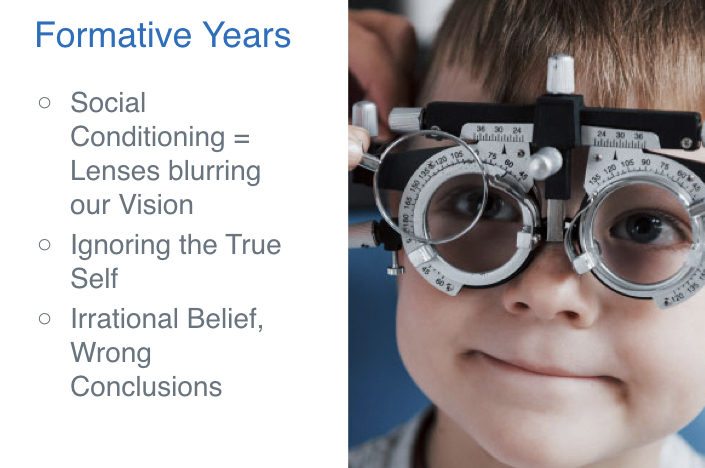
In other words, social conditioning is like a series of lenses that distort your vision. Remember the Man in Plato’s myth? He was the eyes of the Soul, he was the only one who could see the Truth. If you have visited an ophthalmologist, you have probably experienced the process of him or her adding lenses to your vision to see with which ones you see clearly, and in the process a lot of wrong lenses are placed there which are like fog. Well, all these lenses that blur your vision are examples of layers and layers of social conditioning and distorted cognitions about yourselves.
These distorted cognitions and beliefs are, in their core, activities of ignoring your True Self. The more the lenses that blur your vision, the more you move away from the Truth, the more you ignore your True Self. In Phaedrus Myth, the charioteer knew where the chariots needed to go, yeah? However, when the horses were not cooperating, the charioteer was wasting all of his energy in trying to handle the horses with the reins and was losing sight of the Truth, or the ultimate destination. The result of the social conditioning, the lenses that distort your vision is the formation of an irrational belief.
Because in these formative years you, unconsciously, make the wrong conclusions about yourselves. Remember the Attachment Theory? Based on your experiences in that young age from your interaction with your parents, you, most of the time, form an insecure attachment.
Let me give you an example referring back to the incident with the chocolates. I started feeling that I was not important. Of course, this was far from my Truth but my truth was blurred by the lenses, by all the instances in my interactions with my parents and teachers.
Another example I remember, was my aversion to milk, I simply did not want to drink it. However, because my mother perceived that milk was good for me, she would put me on a high ledge in the garden and would not take me down unless I had drunk my milk because it was good for me. Again, my needs were not important and my protest, my knowledge was ignored. The more my needs were ignored and my emotions invalidated, the more the feeling that I was not important was coming back again and again.
By the way, these examples may portray my mother as a monster, which she was not. She was herself also socially conditioned when she was young. I will share more about that later on.
Puberty – A Period of Profound Transition
And eventually we move from early childhood to Puberty. There, a lot is going on. Puberty represents a period of profound transition in terms of drives, emotions, motivations, psychology and social life.
The beginning of adolescence is loosely anchored to the onset of puberty, which brings dramatic alterations in hormone levels and a number of consequent physical changes. Recent preliminary evidence from developmental MRI studies has suggested that the stage of puberty might play an important role in adolescent brain development, perhaps more so than chronological age.
To put it simply, it is when our rational mind is developed. Piaget, a most famous child psychologist marks this as the final stage of his Cognitive Development theory (12 years and up according to his theory) and this stage involves an increase in logic, the ability to use deductive reasoning, and an understanding of abstract ideas.
At this stage, the irrational belief you had about yourselves gets anchored. The way you were feeling about yourselves up to that point gets anchored and the belief, the fake I, is then established and becomes a cognitive distortion.
Cognitive distortions are simply ways that your mind convinces you of something that isn’t really true. These inaccurate thoughts are usually used to reinforce negative thinking or emotions — telling yourself things that sound rational and accurate, but really only serve to keep you feeling bad about yourself. They are thinking errors, if I could put it this way, errors that blur Reality, they are like the lenses and as a result you perceive reality inaccurately.

Cognitive distortions is another huge subject in psychology and I must mention psychiatrist Aaron Beck here who laid the groundwork for the study of these distortions, and his student David Burns continued research on the topic in order for us, the psychologists, to have a list of the most common ones.
Not to get sidetracked here, when this distorted cognition is anchored in puberty, this is when you consequently start to act out on it. This is when your chariot starts getting out of control and is starting a downward spiral moving more and more away from the Truth. When this happens, the Little Self is identifying with the self-image and the cognitive distortion, this thought, this problem, and starts projecting it, I’d dare to say for life, unless you wake up!!
The Stages of Development and the Phaedrus Myth
To bring all the stages of development together and the many centuries of the study of the Soul, let us…go back to the Phaedrus Myth. When the Lion and the Beast cooperate and the Man is able to tame them, then there is balance, no conflict.

In terms of the developmental stages, we could say that the Lion is developed in the formative years, from birth to 6-7 years of age. In these years you are pure feeling. The Lion symbolizes the heart and has one head because there is no conflict.
The Beast is developed in puberty, when it is normal for teenagers to search for their identity and thus explore many things. The rational mind is developed and the many heads symbolize the conflict. The Beast symbolizes the gut.
The Man, is developed after puberty, in young adulthood, anywhere from 18 to 21 years of age. The Man has one head, no conflict there and symbolizes the brain, the mind.
The cooperation of the three are needed for psychosomatic health. Bringing these analogies in practical terms, I will explain the role of the cognitive distortions I spoke about earlier, and how they affect this balance between what we think, what we feel and what we do.
Very briefly, your gut and brain are connected physically through millions of nerves, most importantly the vagus nerve. The gut and its microbes also control inflammation and make many different compounds that can affect the brain. The microbes and the compounds are the many heads of the beast.
How to Identify Cognitive Distortions?
Cognitive Distortions are so powerful that many people go through their lives without even realizing it. What does this mean? It means that their Soul will never manage to take a glimpse of REALITY and they will be operating from their fake “I”, their self-image, which is a result of what? Social Conditioning, the lenses.
Therefore, I find it to be of extreme importance to show you how, when your Psyche identifies with that thinking error and keeps projecting it, what happens to you and how you enter into a vicious circle – the thinking error cycle for life. I will use a diagram to show you briefly this destructive cycle.
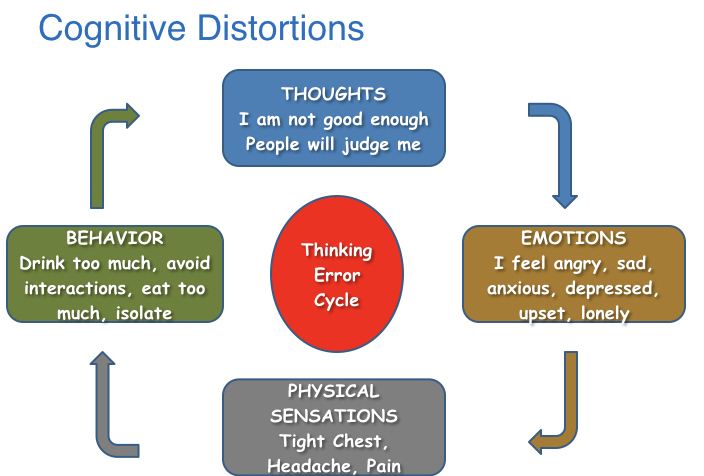
It starts with the way you think about yourselves, which we saw earlier is a product of social conditioning. Let’s say for example, that you think you are not good enough and people will judge you about that. This brings about negative emotions. It could be that you feel angry because other people judge you, or sad because no matter what you do you are not good enough, or you are anxious and develop fear of exposure; or it could be that you are upset because you may perceive constructive feedback as criticism, or even as an attack. You could be depressed because staying in your comfort zone protects you from being judged, so you wallow more and more in self-pity, or you feel lonely because you hide from the world.
Based on the emotions you are experiencing, symptoms start to manifest in your physiology. You may have a headache, or chest pain, it could be any physiological symptom or any disease manifesting here, at this stage.
And the way you deal with these physical sensations, is through dysfunctional behaviors if you are operating from the place of the self-image, the fake I. What do people do? They try to numb the discomfort of negative emotions and their physical pain either by hitting the bottle or overeating, or avoiding stressful interactions, or isolating more and more.
And as a result, these behaviors make you think that you are not good enough, or you messed up again, or that you are a failure and then you feel even worse about it and the cycle keeps repeating itself.
In Psychology, we have tools to identify the cognitive distortions and how to tackle this cycle, which is something I work with in my practice a lot. As a coMra practitioner, clients come to me with the symptom. For them, this is the beginning of the cycle, and yes, we will treat the symptom with coMra. Then, I evaluate how open the client is to explore why he or she has pain, why the symptom is there.
For the clients who are open to see what is going on beyond the face value, I bring to them how our thoughts – emotions – behaviour cycle works. Here, psychology and coMra work well together as, if you remember the first slide about what healing is, it is a process of restoration which requires awareness.
And to heal the relationship with yourselves and others, you also need to re-spect it, to look again at what is going on. Once my clients start becoming aware and respect what is going on in either one of these stages, only then they can start working on themselves in order to shed layer by layer the social conditioning, to stop ignoring the True Self and thus to start the journey of healing.
This cycle is an example of a human soul in the Phaedrus myth. Here, everything starts from the Appettive part, the black horse, which has an excessive appetite for bodily desires (eating, drinking, having sex) and it drives the white horse down as it affects how we feel when we know that what we are doing is life destructive. When the two horses team up (our behavior and desires drive our emotions), we ignore the True Self and the Self-Image gets control of the chariot.
Here, the charioteer who symbolizes true thinking and wisdom stands no chance, and as a result our psyche stands no chance to be liberated. The chariot is driven by the self-image, the fake identity. Thus, when we operate from this thinking error cycle, this is when our mental and physical health start deteriorating.
How Can We Truly Heal Ourselves – The Journey of Adjustment
I am sure that each and every one of you is here by no coincidence. It is probably because you have already started your own Journey of Adjustment towards the liberation of your Soul.

My journey of adjustment started about 11 years ago. Up until that time, for quite a few decades I was mostly running my life based on my own cognitive distortions and my self-image, the fake “I am not important” was in charge. As a result, I chose a career through which my self-image was becoming more and more important. My first degree in the States was in Business Administration, majoring in Marketing. My ambition at the time was to have my own business so that I could, finally prove to my mother and the world around me that I was important. I was not aware of it at the time, I can only see it now because I have embarked on my own Journey of Adjustment.
My ambitions, driven by my fake identity, the self-image, resulted in a lot of doings, of achievements. Slowly but surely I managed to have my own business in the corporate world and a quite successful one. When I finally became a CEO and a President of a BOD, one would think that I would be satisfied. Somehow though, I did not feel as satisfied as I was thinking I would be.
At the time, I was experiencing severe headaches and I would often get a stiff neck. I remember going to the doctor often to get a cortisone injection for my stiff neck, it was that bad! And one morning, I woke up and asked myself “Okay, now what, Panagiota?” The thought of me continuing to work long hours and weekends, to be on the plane all the time, to sleep in hotels, was not appealing anymore. I was experiencing dissatisfaction, low energy and my headaches kept becoming worse.
Once I became aware that this was not how I wanted to go on with life, I started wondering what else I could do. Since I was so business oriented, leaving the corporate world was a bit scary but was also my only option. I could not see myself continuing on that path.
As I was drifting there a bit in search of what to do next, I was feeling a bit lost. I had identified so much with my self-image that I had no clue what else I could do. I only knew I could not continue to be part of the corporate world. And this is when my Journey of Adjustment started. I met a healer who brought to my attention that the symptoms in my physiology were a result of an imbalance, an internal conflict. At first, I could not grasp what he was telling me, however I was eager to learn and open to what he was bringing me.
What he was sharing to me, it all started making sense and this awareness for me was mind blowing. I found out that headaches are a result of when we feel bad about ourselves and that a stiff neck symbolizes inflexibility, a lack of fluidity.
Institute for the Study of Man Course
As I was working with these concepts, trying to truly understand them, he sent me a leaflet about a course that was to take place somewhere in Greece. I read the description of the course and it was about relationships. With no second thoughts I registered and I took a friend with me. This is when I landed on my first ISM course.
ISM stands for Institute for the Study of Man and this is where I first met Elizabeth Schnugh, who was facilitating the course. Elizabeth is the director of ISM and also a co-CEO in RLT. Everything she was saying was making sense, and for the following 5 years, not only I did not miss a course, but I also took my son along to a few.
Then, I asked to become the organizer of these courses in Greece so that more people could learn about themselves. During these 5 years, I came face to face with the effects of social conditioning, my self-image, my distorted belief and started tapping into my inner power and strength.
The Universe is wise. Looking back, I know it was not a coincidence that I landed in the first ISM course back in September of 2010, where I met all of my friends in RLT and became part of the coMra group. I learned a lot about the connection between physiology and psychology and by shedding layer after layer of social conditioning I found my… true calling, which is to help people help themselves.
This is also the vision of ISM and RLT. At the end of 2015, it became clear to me that in order for me to fulfil my purpose in this lifetime, I needed to become a therapist. I went back to school for a fast-track undergraduate degree in Psychology and then a Master’s degree in Counseling Psychology and Psychotherapy, and here I am! Being a therapist is a path with heart for me.
Psychological Self-Healing
The title of this webinar is Psychological Self-Healing and in the beginning of this presentation, I shared a bit about Attachment Theory and how the quality of our interaction with our primary caregivers shapes us in adulthood. There are no perfect mothers, no perfect fathers, and no manuals about how to become the perfect parent.
The relationship with my mother was conflictual because we were so different, however, I know she loved me dearly and she did the best she could! In my practice, I keep telling my clients that the reason we need to go back and see what happened in our childhood is not for us to put our parents against the wall and shoot them, or remain angry with them for the rest of our lives.
Rather it is for us to be aware about what happened; to respect it (look beyond the face value of what happened) in order to learn more about ourselves and others; to forgive our parents for whatever it is that we hold against them, so that we can start getting in touch with how we can change how we feel.
Forgiveness is a conscious decision we make so that we can work with our emotions, these negative unforgiving emotions and replace them with positive other-oriented emotions such as understanding, empathy, etc. to become more emotionally stable.
I was fortunate enough to be able to do that when my mother was still alive, although very ill and in the last year of her life. Being able to see why I was feeling not important and look beyond the face value of my experiences, was able to work with my anger and finally release myself from this emotional prison.
There is so much that I could say, not just for each slide but even for each bullet of each slide as some concepts could be a webinar in themselves, however for the purpose of this presentation I only scratch the surface of this lifetime journey that is called psychological self-healing.
Experiencing Joy
Now, to start wrapping up with the good news
I would say that when you embark on this journey of adjustment, this journey of your psychological healing, you start experiencing joy. Because the less you deal with controlling the beast, the more you can steer your chariot towards high heaven, where reality, true love and wholeness are, the closer you get to joy. I know it, not only because I have read about it in bibliography, but also because I have personal experience with it. Being on a path with heart is most uplifting and joyous!
As we are approaching the end of the presentation, I would like to bring you a “take home message” because I am sure that each and every one of you have gotten whatever it was that you needed from this presentation. Since I spoke of the Thinking Error Cycle though and this is like a program that runs in the background of our operational system – if I could put it this way, in order for you to experience joy you need to harmonize your thoughts, emotions and behavior.

In other words what you think, what you feel and what you do to be in sync! And this is the definition of joy. Now, this is a process and since we all have had academic schooling but not true education while nobody spoke to us about social conditioning and the fake identity, this journey can actually be quite joyous with the proper guidance.
Overthinking Is a Toxic Habit
In therapy we use many tools to support the client in his or her journey towards joy. As I would like to give you a tool to use on your own, what I see in my practice is that most people are a lot in their minds, they overthink.
Overthinking is when the self-image is in control and either thinks excessively about a past event (this is called rumination), or is excessively worrying about a present of future event. When the rational mind gets hooked in one thought – which is always negative, it chops-chops, analyzes-analyzes, repeats-repeats and then there is no room for anything positive to come in.
Overthinking is exhausting. It can waste your emotional energy and make you feel emotionally and physically drained. Overthinking can consume your energy and reduce your ability to make decisions. It sets you up to developing mental illness.
When you overthink, it can snowball into bigger, more extreme negative thinking and you get into a downward spiral – Anxiety, Depression, PTSD, BPD. Signs for that are Phobias, Stress, Fatigue, Indecision, Substance abuse, Loneliness, Sleeplessness, Suicide risk, Excessive food intake, alcohol and drug abuse, smoking, hypercontrol in life, obsession about failure, fear and anxiety about the future, you get the picture.

Overthinking also affects your physiology. You develop illnesses, and research suggests that patients with negative thoughts and anxiety have also experienced headaches, stomach problems and all sorts of body aches that cannot be explained by allopathic medical doctors
If I could put it simply, overthinking is a toxic habit. What can you do to tackle overthinking, to disentangle the knots of negative emotions?
Useful Tools To Support Your Journey Towards Joy

As Robert Frost said, “the best way out is always through”. Again, here there are so many ways and tools to use in an interactive environment, such as individual or group therapy, which could not be used here. Nevertheless, since negative thoughts have to do with the past or the future – rumination or worry – the best way to tackle that is to be here and now.
In this last slide, I will share with you some ways for you to be present, and this can be done by practicing present moment awareness.
Your breathing is a tool you all have no matter where you are. Focusing on your breath allows mindfulness to make you more peaceful and smooth your interactions with others. For me, the master of Mindfulness is Jon Kabat-Zinn and I will share with all of you a link about Breathing Mindfulness with him. Yoga is also another excellent way to be in the present moment. If you are already doing mindfulness breathing meditation, you can use his Body Scan mindfulness meditation.
Keeping a journal. It helps you put your internal dialogue on the paper thus emptying your head from it, and as you write and run out of words you are able to get in touch with your emotions and learn something about yourself – it could be that you usually magnify things in your head, or look at things in a black-white manner, or that you often catastrophize.
Mindful reflection is a technique that needs to be done every night before you go to bed – it is a mindful review of the day. Going back to your day, activity by activity, you see your behavior, what you did or said, how the other people responded and think what you could do differently. This way, you separate the behavior from the person, and learn something you could use in the future. You also address the behavior-emotion-thinking cycle with this practice
Visualization of your day is something to do every morning. Visualizing your goals is an excellent method for not only making it more likely that you will follow through on your goals, it can also help you become more mindful on a regular basis. When you have set your daily goals, take a few moments to visualize each one. See yourself undertaking each goal and completing each goal today. Get as much detail as you can in your visualization, so it feels real and within your reach. When you can see yourself checking that daily goal off your list, move on to the next goal and repeat until you have visualized all of your daily goals.
The Gratitude Jar. A gratitude jar is a fun way to create a visual reminder of all the blessings in your lives. Essentially, it is a place to record and store everything you’re thankful for. Whether it’s a person, a kind act or a positive detail in your everyday life, write it down on a slip of paper and stick it in your gratitude jar. Over time, you’ll have a jar full of all the blessings in your life. Creating a gratitude jar is an easy, quick and inexpensive way to practice gratitude. It’s a way to build a new habit of thankfulness and it only takes a few seconds a day. Make sure you decorate it nicely, so that it looks really nice.
Lastly, ask for support!
Thank you so much for being here with me today!
Contact us at https://comra-palm.com/
More info at https://comra-therapy.com/
Watch the video recording of the webinar below :
References
- Albert, D., Chein, J., & Steinberg, L. (2013). Peer Influences on Adolescent Decision Making. Current directions in psychological science, 22(2), 114–120. https://doi.org/10.1177/0963721412471347
- Berzoff, J. (2011). Psychosocial ego development: The theory of Erik Erikson. Inside out and outside in: Psychodynamic clinical theory and psychopathology in contemporary multicultural contexts, 97-118.
- Blakemore, S. J., Burnett, S., & Dahl, R. E. (2010). The Role of Puberty in the Developing Adolescence. Human Brain Mapping, 31(6): 926–933, doi: 10.1002/hbm.21052
- Bretherton, I. (1992). The origins of attachment theory: John Bowlby and Mary Ainsworth. Developmental psychology, 28(5), 759.
- Ch’ng Pei Eng, C. Y., Ming, C. S. P., & MHRO, A. Think+ Think+… Think= Overthinking. TEACHING AND LEARNING IN HIGHER EDUCATION (TLHE), 45.
- McCullough, M. E. (2001). Forgiveness: Who does it and how do they do it?. Current directions in psychological science, 10(6), 194-197.
- Petric, D. Emotional knots and overthinking.
- Piaget J. (1976) Piaget’s Theory. In: Inhelder B., Chipman H.H., Zwingmann C. (eds) Piaget and His School. Springer Study Edition. Springer, Berlin, Heidelberg. https://doi.org/10.1007/978-3-642-46323-5_2
- Werner, D. S. (2012). Myth and Philosophy in Plato’s Phaedrus. Cambridge University Press.